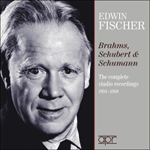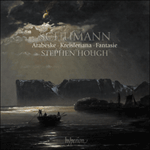
Welcome to Hyperion Records, a British classical label devoted to presenting high-quality recordings of music of all styles and from all periods from the twelfth century to the twenty-first.
Hyperion offers both CDs, and downloads in a number of formats. The site is also available in several languages.
Please use the dropdown buttons to set your preferred options, or use the checkbox to accept the defaults.

The first two publishers he contacted, Kistner and Haslinger, were unconvinced by this plan, so he approached the prestigious firm Breitkopf & Härtel, who accepted it. After it had been engraved, Schumann requested a change of title to ‘Fantasy’; he told Clara Wieck that it was dedicated to Liszt, their colleague and her rival on the concert stage. But he also wrote:
You can understand the fantasy only if you think back to the unhappy summer of 1836, when I renounced you; now I have no reason to compose such unhappy and melancholy music.
She, in turn, responded:
Yesterday I received your wonderful fantasy—today I am still half ill with rapture; as I played through it I was drawn involuntarily towards the window, and there I felt like leaping out to the beautiful spring flowers and embracing them.
The work therefore bears several associations, public and private, professional and personal, historical and autobiographical. Furthermore, Schumann referred to it variously as a ‘sonata’, a ‘fantasy’, ‘fantasy pieces’ and ‘poems’ (‘Dichtungen’), leaving open the question of how he envisioned the work. The order of movements, namely fast-fast-slow, rather than fast-slow-fast, differs from most sonatas, although there is an affinity with the unconventional world of Beethoven’s late works in that genre. They also have unusual titles, rather than the usual anonymous allegros or andantes: ‘To be performed completely with fantasy and passion’; ‘Moderate, but with energy’; and ‘Solemn and slow, to be played quietly throughout’. With the first movement, we embark on a thrilling journey, eventually coming to rest with a tender quotation from Beethoven’s song cycle An die ferne Geliebte (‘To the distant beloved’, surely recalling Clara Wieck). The second movement, a robustly extrovert march which she particularly loved, is followed by a third movement which floats, unmoored, through a dreamscape of linked harmonies, and it remains one of the most intimate and exquisite of piano movements.
from notes by Natasha Loges © 2021
Les deux premiers éditeurs qu’il contacta, Kistner et Haslinger, n’étaient pas convaincus par ce projet; il s’adressa donc à la prestigieuse maison d’édition Breitkopf & Härtel, qui l’accepta. L’œuvre était déjà gravée quand Schumann demanda de changer le titre pour celui de «Fantaisie»; il dit à Clara Wieck qu’elle était dédiée à Liszt, leur collègue et le rival de Clara sur la scène de concert. Mais il écrivit aussi:
Pour que tu comprennes bien la fantaisie, il faut que tu te reportes à ce malheureux été 1836 où j’avais dû renoncer à toi; maintenant, je n’ai plus aucune raison de composer une musique triste et mélancolique.
Elle lui répondit:
Hier, j’ai reçu ta merveilleuse fantaisie—aujourd’hui je suis encore à moitié malade d’exaltation; en la jouant j’ai été attirée involontairement vers la fenêtre et, là, j’ai eu envie de sauter vers les magnifiques fleurs de printemps et de les étreindre.
Il y a donc dans cette œuvre plusieurs éléments associés, publics et privés, professionnels et personnels, historiques et autobiographiques. En outre, Schumann l’appelait à tour de rôle «sonate», «fantaisie», «pièces de fantaisie» et «poèmes» («Dichtungen»), laissant ouverte la question de savoir comment il imaginait cette œuvre. L’ordre des mouvements, à savoir rapide-rapide-lent plutôt que rapide-lent-rapide, diffère de celui de la plupart des sonates, même s’il y a une ressemblance avec l’univers non conventionnel des dernières œuvres de ce genre chez Beethoven. Ils portent aussi des titres inhabituels, au lieu des usuels allegro et andante anonymes: «À jouer entièrement avec fantaisie et passion»; «Modéré, mais avec énergie»; et «Solennel et lent, à jouer calmement du début à la fin». Avec le premier mouvement, on s’embarque dans un voyage palpitant, qui finit par s’immobiliser sur une tendre citation du cycle de lieder de Beethoven An die ferne Geliebte («À la bien-aimée lointaine», sûrement une évocation de Clara Wieck). Le deuxième mouvement, une marche foncièrement extravertie qu’elle aimait particulièrement, est suivi d’un troisième mouvement qui flotte, libre de toute amarre, dans un paysage imaginaire d’harmonies liées, et reste l’un des mouvements pianistiques les plus intimes et magnifiques.
extrait des notes rédigées par Natasha Loges © 2021
Français: Marie-Stella Pâris
Die ersten beiden Verleger, an die er sich wandte, Kistner und Haslinger, waren von diesem Plan nicht überzeugt, woraufhin er bei dem renommierten Haus Breitkopf & Härtel vorsprach, welches zusagte. Nachdem die Noten gestochen worden waren, bat Schumann, den Titel in „Fantasie“ umzuändern und teilte Clara Wieck mit, dass es Franz Liszt gewidmet sei, ihrem Kollegen aber auch Rivalen auf der Konzertbühne. Er fügte jedoch hinzu:
Die Phantasie kannst Du nur verstehen, wenn Du Dich in den unglücklichen Sommer 1836 zurückversetzt, wo ich Dir entsagte; jetzt habe ich keine Ursache so unglücklich und melancholisch zu komponieren.
Darauf antwortete sie:
Gestern hab ich Deine wunderherrliche Fantasie erhalten—ich bin noch heute halb krank vor Entzücken; als ich sie durchgespielt, trieb es mich unwillkürlich an das Fenster, und da war mir es doch, als müßte ich mich hinausstürzen auf die schönen Frühlingsblumen und sie umarmen.
In dem Werk klingen also allerlei Anspielungen mit, öffentliche und private, berufliche und persönliche, historische und autobiographische. Außerdem verlieh Schumann ihm unterschiedliche Titel—von „Sonate“ über „Phantasie in drei Sätzen“ bis hin zu „Dichtungen“—was die Frage offen lässt, wie er sich das Werk genau vorstellte. Die Satzfolge, nämlich schnell-schnell-langsam anstelle von schnell-langsam-schnell, weicht von den meisten Sonaten ab, obwohl es eine gewisse Affinität zu der unkonventionellen Welt von Beethovens späten Werken in diesem Genre aufweist. Die Satztitel tragen zudem statt der üblichen anonymen Allegros oder Andantes ungewöhnliche Titel: „Durchaus phantastisch und leidenschaftlich vorzutragen“, „Mäßig: Durchaus energisch“ und „Langsam getragen: Durchweg leise zu halten“. Mit dem ersten Satz begeben wir uns auf eine aufregende Reise, die schließlich mit einem zarten Zitat aus Beethovens Liederzyklus An die ferne Geliebte (womit hier sicher Clara Wieck gemeint ist) endet. Auf den zweiten Satz, ein robust-extravertierter Marsch, den sie besonders liebte, folgt ein dritter Satz, der losgelöst durch eine Traumlandschaft von verknüpften Harmonien schwebt und auch heute noch zu den intimsten und exquisitesten Klaviersätzen überhaupt zählt.
aus dem Begleittext von Natasha Loges © 2021
Deutsch: Viola Scheffel
 Edwin Fischer - The complete Brahms, Schubert & Schumann studio recordings, 1934-1950 Edwin Fischer - The complete Brahms, Schubert & Schumann studio recordings, 1934-1950 |
 Piano Works, Vol. 1 Piano Works, Vol. 1Llŷr Williams’ long and successful collaboration with Signum Records continues with this survey of Schumann’s piano works, beginning with the early 'Papillons' completed when he was just twenty.» More |
 Schumann: Arabeske, Kreisleriana & Fantasie Schumann: Arabeske, Kreisleriana & FantasieThe emotional sweep of these three marvellous works, reflecting the vicissitudes of Schumann’s complex personal life at the time, calls for a pianist wholly responsive to their fervent Romanticism. The artistry of Stephen Hough proves ideal.» More |

